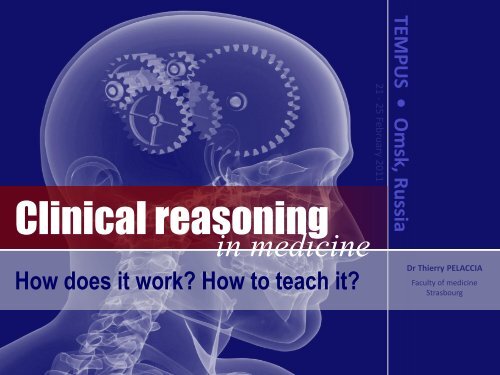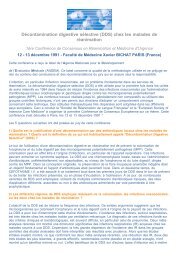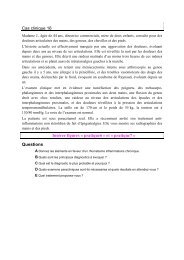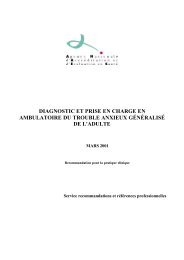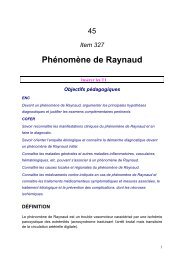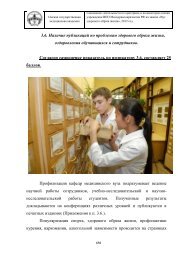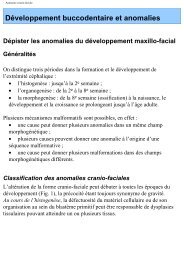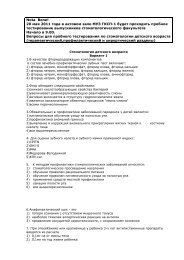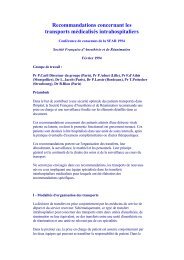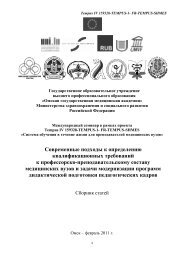Clinical reasoning En
Clinical reasoning En
Clinical reasoning En
You also want an ePaper? Increase the reach of your titles
YUMPU automatically turns print PDFs into web optimized ePapers that Google loves.
The answers…<strong>Clinical</strong> <strong>reasoning</strong> is knownas the physician’s mostcritical competence!CHARLIN et al, 2000HIGGS & JONES, 2008NORMAN, 2005SCHWARTZ & ELSTEIN, 2008…
Teachingclinical <strong>reasoning</strong>
What isclinical <strong>reasoning</strong>?
<strong>Clinical</strong> <strong>reasoning</strong> processesYou are all health professionalsYou are all actors in clinical situationsYou are all human beingsAs a resultyou use <strong>reasoning</strong> processesconstantly in your everyday life!
Intuitive processesEVA, 2005 | HOGARTH, 2005 | PELACCIA et al, 2011Most common form = pattern recognitionPrinciplesMaking unconsciously a link between a given clinicalsituation and patterns stored in the long-term memory,through the automated identification and treatment ofclinical and contextual information.GoalFormulate diagnostic hypotheses very fast when meetinga patient for the first time.
Intuitive processesCROSKERRY, 2009 | EVA, 2005 | HOGARTH, 2005Features• unconscious• very fast• irrepressible• similarity judgment based on a few clinical andcontextual data• source of errors• efficacy based on clinical experience• decisive
Analytical processesEVA, 2005 | NENDAZ et al, 2005Most common form = hypothetico-deductionPrinciplesTesting analytically the diagnostic hypotheses that havebeen raised intuitively (by questioning the patient, makinga clinical examination, etc.)ObjectiveTo confirm or invalidate solutions that have beengenerated intuitively
2 examples of <strong>reasoning</strong> in E.M.The triage nurse tells you…• an ambulance is coming from a caraccident scene with an unconscious patientImmediately, you think about…• severe cranial traumaContextual andclinical dataIntuitive<strong>reasoning</strong>When meeting the patient, you look for…• scalp wound,• anisocoria,• etc.Analytical<strong>reasoning</strong>(hypothetico-deductive)
2 examples of <strong>reasoning</strong> in E.M.The triage nurse tells you…• you should see the young womanroom 2. She has a severe headacheContextual andclinical dataImmediately, you think about…• subarachnoid hemorrhage• meningitisIntuitive<strong>reasoning</strong>When meeting the patient, you look for…• nuchal rigidity,• fever,• etc.Analytical<strong>reasoning</strong>(hypothetico-deductive)
<strong>Clinical</strong> <strong>reasoning</strong>INTERMEDIATE SUMMARYWhen meeting a patient, a physician:• formulates diagnostic hypotheses within the firstseconds or minutes, based on immediatelyavailable contextual and clinical data= intuitive <strong>reasoning</strong>• performs patient’s questioning, clinicalexamination and complementary investigations toconfirm or invalidate hypotheses that have beenraised intuitively= analytical (hypothetico-deductive) <strong>reasoning</strong>
OK, but…Anyone can reasonintuitively andanalytically whenmeeting a patient!
The experts…CHAMBERLAND, 2005 | NORMAN, 2005Use <strong>reasoning</strong> processesUse knowledge that has beenspecifically organized toreason in the clinical practice
Knowledge used to reasonCHAMBERLAND, 2005 | NORMAN, 2005Size is not important…Organizationis the main!
Knowledge used to reasonCHAMBERLAND, 2005 | NORMAN, 2005In experts, knowledgeis commonly organized into3 cognitive models• instances• prototypes• illness scripts
Knowledge used to reasonInstancesPast cases stored in the long-term memoryCHARLIN et al, 2007 | GRUPPEN et al, 2002 | NENDAZ et al, 2005PrototypesTransformation and abstraction of past cases stored in thelong-term memory. The disease is represented by a typicalassociation of signs (with several variants)Prototype myocardial infarct = mature man – retrosternal chest pain –sweatingVariant #1 = mature man – epigastric pain – sweating
Knowledge used to reasonIllness scriptCHARLIN et al, 2007 | GRUPPEN et al, 2002 | NORMAN, 2005Story-like narration of a typical case of the conditionScript « pizzeria » = I enter the restaurant – An Italian waiter will bewelcoming me – He will take me to the table I booked – He will give me themenu and suggest the day menu – He will ask if I want to drink something,etc.Script « multiple injured patient » = I will first assess vital signs – I will asksome information about what happened – I will auscultate his lung to lookfor a pleural effusion – I will palpate the abdomen to see if it is painful – Iwill palpate limbs to seek for pain, etc.Illness scripts are dedicated to a specific task (diagnostic,therapeutic, etc.)
The links between processes and knowledgePELACCIA et al, 2011Instances and prototypesare at the basis ofintuitive <strong>reasoning</strong>Illness scriptsare at the basis ofhypothetico-deductive <strong>reasoning</strong>
<strong>Clinical</strong> <strong>reasoning</strong>INTERMEDIATE SUMMARYPhysicians’ clinical <strong>reasoning</strong> rests upon:• general processes of <strong>reasoning</strong>: intuitive andanalytical (hypothetico-deductive)• specifically organized knowledge: instances,prototypes, illness scriptsCognitive models of knowledge organization are atthe basis of <strong>reasoning</strong> processes<strong>Clinical</strong> experience plays a major role in organizingknowledge
How to teachclinical <strong>reasoning</strong>?
How to teach clinical <strong>reasoning</strong>?Teachingclinical <strong>reasoning</strong>requires to follow• the general principles of learning• some specific principles related to thisfield of expertise
The specific principlesARK et al, 2006 | CHAMBERLAND et al, 2005 | NENDAZ et al, 2005The learning of processesshould not be separated fromthe learning of knowledgeThe learning of processesshould take into account the2 dimensions of clinical <strong>reasoning</strong>(intuitive and analytical)
5 principles to teach clinical <strong>reasoning</strong>Teachers and learners should know what is clinical <strong>reasoning</strong> to talkabout clinical <strong>reasoning</strong>• plan a short teaching sequence on thistopic• give learners short reviews about thesubject• use the « words » of clinical <strong>reasoning</strong>when speaking of clinical <strong>reasoning</strong>
5 principles to teach clinical <strong>reasoning</strong>Get the learner involved in the learning process• training periods should be more than makingtechnical and administrative tasks, and followingexperienced practitioners when visiting patients• clinical case presentations should not be turnedinto expert conferences• the audience should be involved in caseresolution from the beginning of thepresentation
5 principles to teach clinical <strong>reasoning</strong>Give learners the opportunity to reason in a realistic context• do not give the solution before the learnerstarts to reason• do not reveal all data at one time• choose adequately the order in which datawill be given to the learners• give relevant and non-relevant data
5 principles to teach clinical <strong>reasoning</strong>Learners should be encouraged to use both intuitive and analyticalprocesses• ask explicitly learners to adopt a multiprocessingapproach• give students the opportunity to formulatediagnostic hypotheses from the first seconds orminutes of encountering the patient• ask students to adopt a targeted approach whencollecting information, to confront diagnostichypotheses and to reduce the field of hypotheses
5 principles to teach clinical <strong>reasoning</strong>Help learners to organize their knowledge according to cognitive modelsthat are useful for <strong>reasoning</strong>• confront learners with multiples cases, in a widerange of contexts and presentations• to start with, confront novice learners with typicalpresentations of a given disease and,subsequently, with more atypical situations• ask students to generalize or discriminatebetween the situations
Programs dedicated to clinical <strong>reasoning</strong>• <strong>Clinical</strong> <strong>reasoning</strong> learning (CRL)• Metaplan method• Problem solving clinical seminars• <strong>Clinical</strong> problem solving conference• The scheme approach• Principles of clinical <strong>reasoning</strong>• <strong>Clinical</strong> <strong>reasoning</strong> theaterCHAMBERLAND, 1998NENDAZ et al, 1998STRUYF et al, 2005DHALIWAL et al, 2009MANDIN et al, 1997WINDISH, 2000BORLEFFS et al, 2003
<strong>Clinical</strong> <strong>reasoning</strong>FINAL SUMMARY• clinical <strong>reasoning</strong> is a core medical competency clinical <strong>reasoning</strong> should be taught and learned• in order to teach clinical <strong>reasoning</strong>:- teachers and learners should speak the language ofclinical <strong>reasoning</strong>- learners should be actively involved in the learningprocess- learners should have the opportunity to reason in acontext close to the clinical reality- learners should be trained to use both intuitive andanalytical processes- learners should have the opportunity to organize theirknowledge adequately
Thank you for your attention!thierry.pelaccia@wanadoo.fr


